A Novel Bio-Architectural Temporary Housing Designed for the Mediterranean Area: Theoretical and Experimental Analysis
Abstract
:1. Introduction
2. Materials and Methods
2.1. Physical Properties of the Panels Constituting the Envelope
- (1)
- limitation of the assembling time;
- (2)
- limited weight (lower than 20 kg) that allows it to be managed by a single worker;
- (3)
- suitable mechanical, acoustic and thermal requirements;
- (4)
- potential complete recovery and recycling of every involved material.
2.2. SuberWall Panels including Bio-PCM
2.3. EnergyPlus Model
3. Results
3.1. Bio-PCM Analysis in Free-Floating Conditions
3.2. Bio-PCM Analysis with an Operating Split System
3.2.1. Temperature Analysis
3.2.2. Energy Analysis
4. THU with a BIPV
- self-produced electricity that meets the users’ needs by reducing the withdrawal of electricity from the grid and by favoring the energy community’s development;
- roof protection from atmospheric agents;
- roof shading in summer.
5. Experimental Tests
6. Conclusions
- lower environmental impact compared to traditional materials used in the construction sector;
- low weight and facilitation in the transport and the assembling phases;
- simplification of the subsequent disassembly and possible recycling of the materials;
- appreciable structural, thermal and acoustic performances.
- PCMs allow for obtaining evident benefits in terms of annual thermal energy requirements due to the obtained increase in the number of hours per year in which it is possible to avoid the operation of the HVAC system. In particular, in the best of cases, the percentages of hours go from 26% (without PCM) to 36% (with a bio-PCM with a melting temperature of 23 °C);
- the bio-PCM with a melting temperature of 23 °C produced large benefits, especially in the summer and autumn months, due to the considered climatic context in which cooling needs are dominant. Instead, it was observed that a PCM with a melting temperature equal to 29 °C produces a worse energy performance due to the low frequency with which the material liquefaction occurs;
- bio-PCM23 was also confirmed as the best choice by the analysis of the thermal energy coming into the internal environment in the winter and the autumn months, confirmed by the storage and the subsequent release of the latent energy that delays the indoor air temperature drop by limiting heating demands. Similarly, there is a noticeable reduction in the incoming thermal energy in the summer months due to the solar gain storage of latent energy, successively discharged outward by natural ventilation with favorable temperatures;
- the electricity absorbed by the split system reduces with the scheduled operation without compromising the thermal comfort conditions excessively and, moreover, the intermittent functioning amplifies the PCM benefits due to better exploitation of the THU thermal inertia;
- a monthly report on the electricity consumption among the considered cases has shown that a double layer of PCM23 reduces electric consumption, especially in summer, with savings ranging between 25% and 65%;
- regarding a THU not equipped with PCM, a comparison of annual electricity consumption has highlighted that it is possible to achieve savings of about 7–8% when a single layer of PCM23 is adopted, and by approximately 26% by doubling the PCM23 quantity;
- a double PCM23 layer, although it does not involve large variations in the hourly and monthly average internal air temperatures (there is a maximum variation of about 0.3 °C in the monthly average values), makes it possible to significantly reduce electricity consumption;
- the use of a BIPV roof system combined with an electric storage system allows full satisfaction of the electricity consumption and leaves a certain safety margin to cover other electrical loads;
- experimental tests on a SuberWall sample equipped with bio-PCM23 on the inner side carried out in a climatic chamber confirmed the beneficial effects of the material transition phase. By applying a temperature difference of 25 °C on the external hot side instantaneously, in 100 h the internal surface temperature did not reach a stabilized temperature trend. With a sinusoidal solicitation having an amplitude of 12.5 °C and an average value of 22.5 °C, the time shift was 6.7 h, the attenuation factor was 0.309 and the periodic thermal transmittance was 0.093 W/m2K. The latter value respects the current regulation constraint of, in new buildings, a value lower than the threshold of 0.10 W/m2K. Despite the PCM’s employment, the time shift is 6.7 h, confirming that a THU without PCM will be affected by sure and sudden indoor temperature oscillations.
Author Contributions
Funding
Informed Consent Statement
Data Availability Statement
Conflicts of Interest
References
- Algieri, A.; Morrone, P.; Perrone, D.; Bova, S.; Castiglione, T. Analysis of multi-source energy system for small-scale domestic applications. Integration of biodiesel, solar and wind energy. Energy Rep. 2020, 6, 652–659. [Google Scholar] [CrossRef]
- Ayarkwa, J.; Joe Opoku, D.G.; Antwi-Afari, P.; Man Li, R.Y. Sustainable building processes’ challenges and strategies: The relative important index approach. Clean. Eng. Technol. 2022, 7, 100455. [Google Scholar] [CrossRef]
- IEA. IEA Tracking Buildings 2020; IEA: Paris, France, 2020. [Google Scholar]
- Ochab, P.; Kokoszka, W.; Kogut, J.; Skrzypczak, I.; Szyszka, J.; Starakiewicz, A. Passive Residential Houses with the Accumulation Properties of Ground as a Heat Storage Medium. In Proceedings of the IOP Conference Series: Earth and Environmental Science, Shanghai, China, 19–22 October 2017. [Google Scholar]
- Chayaamor-Heil, N.; Hannachi-Belkadi, N. Towards a platform of investigative tools for biomimicry as a new approach for energy-efficient building design. Buildings 2017, 7, 19. [Google Scholar] [CrossRef] [Green Version]
- Telichenko, V.; Benuzh, A.; Eames, G.; Orenburova, E.; Shushunova, N. Development of Green Standards for Construction in Russia. Procedia Eng. 2016, 153, 726–730. [Google Scholar] [CrossRef] [Green Version]
- Bruno, R.; Arcuri, N.; Carpino, C. Study of innovative solutions of the building envelope for passive houses in Mediterranean areas. Energy Procedia 2017, 140, 80–92. [Google Scholar] [CrossRef]
- Bruno, R.; Arcuri, N.; Carpino, C. The passive house in Mediterranean area: Parametric analysis and dynamic simulation of the thermal behavior of an innovative prototype. Energy Procedia 2015, 82, 533–539. [Google Scholar] [CrossRef] [Green Version]
- Eurostat: Migration Data Portal; EAS Office. Annual Report on 2021 European Migrant Fluxes; 2021; ISBN 9789294650535. Available online: https://ec.europa.eu/eurostat/statistics-explained/index.php?title=Migration_and_migrant_population_statistics (accessed on 19 March 2022).
- Commission, E. Potential Ukrainian Refugee Crisis: European Parliamentary Question. Available online: https://www.europarl.europa.eu/doceo/document/E-9-2022-000368_EN.pdf (accessed on 19 March 2022).
- Fekete, A.; Bross, L.; Krause, S.; Neisser, F.; Tzavella, K. Bridging gaps in minimum humanitarian standards and shelter planning by critical infrastructures. Sustainability 2021, 13, 849. [Google Scholar] [CrossRef]
- Available online: https://www.sustanzeb.org/ (accessed on 19 March 2022).
- Barreca, F.; Arcuri, N.; Cardinali, G.D.; Di Fazio, S. A bio-based render for insulating agglomerated cork panels. Coatings 2021, 11, 1478. [Google Scholar] [CrossRef]
- Bruno, R.; Bevilacqua, P.; Arcuri, N. Assessing cooling energy demands with the EN ISO 52016-1 quasi-steady approach in the Mediterranean area. J. Build. Eng. 2019, 24, 100740. [Google Scholar] [CrossRef]
- Marino, C.; Nucara, A.; Panzera, M.F.; Pietrafesa, M. Towards the nearly zero and the plus energy building: Primary energy balances and economic evaluations. Therm. Sci. Eng. Prog. 2019, 13, 100400. [Google Scholar] [CrossRef]
- Čekon, M.; Plášek, J.; Slávik, R.; Fečer, T.; Juráś, P. An Experimental and Numerical Model of a Solar Facade Prototype with Transparent Insulation and Selective Absorber. In Proceedings of the SimBuild, Building Performance Analysis Conference, Chicago, IL, USA, 26–28 September 2018. [Google Scholar]
- Carpino, C.; Bruno, R.; Bevilacqua, P.; Arcuri, N. Are ICFs Suitable Building Envelope Solutions for Mediterranean Climatic Conditions? A Critical Analysis Concerning Thermal Properties and Annual Energy Performances. In Proceedings of the Building Simulation 2019: 16th Conference of IBPSA, Rome, Italy, 2–4 September 2020; Volume 16, pp. 480–487. [Google Scholar]
- Detommaso, M.; Evola, G.; Gagliano, A.; Marletta, L.; Nocera, F. Thermal performance of innovative building envelope systems in mediterranean climate. Build. Simul. Appl. 2017, 77–85. Available online: https://www.google.com.hk/url?sa=t&rct=j&q=&esrc=s&source=web&cd=&cad=rja&uact=8&ved=2ahUKEwiy2t3O1bb3AhXrgv0HHUTcCLUQFnoECA4QAQ&url=http%3A%2F%2Fwww.ibpsa.org%2Fproceedings%2FBSA2017%2F9788860461360_10.pdf&usg=AOvVaw0okhvCVz-47kbtvGy53qju (accessed on 19 March 2022).
- Barreca, F.; Cardinali, G.D.; Fichera, C.R.; Praticò, P. Utilization of cork residues for high performance walls in green buildings. Agric. Eng. Int. CIGR J. 2018, 20, 47–55. [Google Scholar]
- Faraj, K.; Khaled, M.; Faraj, J.; Hachem, F.; Castelain, C. A Summary Review on Experimental Studies for PCM Building Applications: Towards Advanced Modular Prototype. Energies 2022, 15, 1459. [Google Scholar] [CrossRef]
- Dash, S.P.; Pati, D.J.; Mohamed, Z.S.; Ramesh, S. To study the material feasibility and propose design prototype for temporary housing structures for emergency relief. Mater. Today Proc. 2021. [Google Scholar] [CrossRef]
- Seike, T.; Isobe, T.; Hosaka, Y.; Kim, Y.; Watanabe, S.; Shimura, M. Design and supply system for emergency temporary housing by various construction methods from the perspective of environmental impact assessment: The case for the Great East Japan earthquake. Energy Build. 2019, 203, 109425. [Google Scholar] [CrossRef]
- Seike, T.; Kim, Y.; Hosaka, Y.; Ida, S.; Masuda, T. Intraregional reuse of emergency temporary housing in Japan. Sustain. Cities Soc. 2018, 42, 650–662. [Google Scholar] [CrossRef]
- Hosseini, S.M.A.; Farahzadi, L.; Pons, O. Assessing the sustainability index of different post-disaster temporary housing unit configuration types. J. Build. Eng. 2021, 42, 102806. [Google Scholar] [CrossRef]
- Asfour, O.S. Learning from the past: Temporary housing criteria in conflict areas with reference to thermal comfort. Int. J. Disaster Risk Reduct. 2019, 38, 101206. [Google Scholar] [CrossRef]
- Hosseini, S.M.A.; Yazdani, R.; Fuente, A. de la Multi-objective interior design optimization method based on sustainability concepts for post-disaster temporary housing units. Build. Environ. 2020, 173, 106742. [Google Scholar] [CrossRef]
- Amin Hosseini, S.M.; De La Fuente, A.; Pons, O. Multi-criteria decision-making method for assessing the sustainability of post-disaster temporary housing units technologies: A case study in Bam, 2003. Sustain. Cities Soc. 2016, 20, 38–51. [Google Scholar] [CrossRef]
- D’Orazio, M.; Maracchini, G. An experimental investigation on the indoor hygrothermal environment of a reinforced-EPS based temporary housing solution. Energy Build. 2019, 204, 109500. [Google Scholar] [CrossRef]
- Cork in the Building Sector: New Possible Scenarios in Sardinia. Available online: https://www.teknoring.com/news/materiali-da-costruzione/sughero-espanso-caratteristiche-e-utilizzi/ (accessed on 19 March 2022).
- Novais, R.M.; Carvalheiras, J.; Senff, L.; Lacasta, A.M.; Cantalapiedra, I.R.; Giro-Paloma, J.; Seabra, M.P.; Labrincha, J.A. Multifunctional cork—Alkali-activated fly ash composites: A sustainable material to enhance buildings’ energy and acoustic performance. Energy Build. 2020, 210, 109739. [Google Scholar] [CrossRef] [Green Version]
- Merabti, S.; Kenai, S.; Belarbi, R.; Khatib, J. Thermo-mechanical and physical properties of waste granular cork composite with slag cement. Constr. Build. Mater. 2021, 272, 121923. [Google Scholar] [CrossRef]
- Chanut, J.; Wang, Y.; Dal Cin, I.; Ferret, E.; Gougeon, R.D.; Bellat, J.P.; Karbowiak, T. Surface properties of cork: Is cork a hydrophobic material? J. Colloid Interface Sci. 2022, 608, 416–423. [Google Scholar] [CrossRef] [PubMed]
- Cork in Buildings: Properties. Available online: https://www.teknoring.com/news/materiali-da-costruzione/sughero-espanso-caratteristiche-e-utilizzi/ (accessed on 19 March 2022).
- Barreca, F. Demountable Building Module Consisting of a Structure Modular Bearing and Cladding in Modular Multilayer Panels in Agglomerated Cork 20196. Available online: https://www.knowledge-share.eu/en/patent/removable-building-module-consisting-of-a-modular-supporting-structure/ (accessed on 19 March 2022).
- Evola, G.; Marletta, L. The Solar Response Factor to calculate the cooling load induced by solar gains. Appl. Energy 2015, 160, 431–441. [Google Scholar] [CrossRef]
- Italian interministerial decree 26th June 2015: Application of calculation methods for energy performance and definition of minimum building requirements. Off. Gazzette Ital. Repub. 2015, 1–8. Available online: https://www.mise.gov.it/images/stories/normativa/DM_requisiti_minimi.pdf (accessed on 19 March 2022).
- Peel, M.C.; Finlayson, B.L.; McMahon, T.A. Updated world map of the Köppen-Geiger climate classification. Hydrol. Earth Syst. Sci. 2007, 11, 1633–1644. [Google Scholar] [CrossRef] [Green Version]
- UNI 10349-3; Heating and Cooling of Buildings—Climatic Data Part 3—Accumulated Temperature Differences (Degree-Days) and other Indices. Italian Unification Institution: Roman, Italy, 2016.
- Wang, X.; Li, W.; Luo, Z.; Wang, K.; Shah, S.P. A critical review on phase change materials (PCM) for sustainable and energy efficient building: Design, characteristic, performance and application. Energy Build. 2022, 260, 111923. [Google Scholar] [CrossRef]
- Boussaba, L.; Lefebvre, G.; Makhlouf, S.; Grados, A.; Royon, L. Investigation and properties of a novel composite bio-PCM to reduce summer energy consumptions in buildings of hot and dry climates. Sol. Energy 2021, 214, 119–130. [Google Scholar] [CrossRef]
- DesignBuilder Software Ltd. User Manual of the Software; Version 6; Design Builder: Trieste, Italy, 2018. [Google Scholar]
- UNI/TS 11300–1; Building Energy Performance—Part 1: Evaluation of the Energy Need for Space Heating and Cooling. 2014; (In Italian). Available online: https://global.ihs.com/doc_detail.cfm?document_name=UNI%2FTS%2011300%2D1&item_s_key=00648079 (accessed on 19 March 2022).
- CEN EN 12831-1:2017; Energy Performance of Buildings—Method for Calculation of the Design Heat Load—Part 1: Space Heating Load. Comite Europeen de Normalisation: Brussels, Belgium, 2017.
- Italian Republic. Italian Decree 412/93 on Regulations for the Design, Installation, Operation and Maintenance of the Heating Systems of the Buildings for the Purpose of Containing Energy Consumption. 1993. Available online: https://www.gazzettaufficiale.it/eli/id/1993/10/14/093G0451/sg (accessed on 19 March 2022).
- Bać, A.; Nemś, M.; Nemś, A.; Kasperski, J. Sustainable integration of a solar heating system into a single-family house in the climate of Central Europe—A case study. Sustainability 2019, 11, 4167. [Google Scholar] [CrossRef] [Green Version]
- Malara, A.; Marino, C.; Nucara, A.; Pietrafesa, M.; Scopelliti, F.; Streva, G. Energetic and economic analysis of shading effects on PV panels energy production. Int. J. Heat Technol. 2016, 34, 465–472. [Google Scholar] [CrossRef]
- Bevilacqua, P.; Perrella, S.; Cirone, D.; Bruno, R.; Arcuri, N. Efficiency improvement of photovoltaic modules via back surface cooling. Energies 2021, 14, 895. [Google Scholar] [CrossRef]
- Bruno, R.; Bevilacqua, P.; Cuconati, G.; Arcuri, N. An innovative compact facility for the measurement of the thermal properties of building materials: First experimental results. Appl. Therm. Eng. 2018, 143, 947–954. [Google Scholar] [CrossRef]
- EN ISO 13786; Thermal Performance of Building Components—Dynamic Thermal Characteristics—Calculation Methods. European Committee for Standardisation: Brussels, Belgium, 2018. Available online: https://www.en-standard.eu/iso-13786-thermal-performance-of-building-components-dynamic-thermal-characteristics-calculation-methods/ (accessed on 19 March 2022).



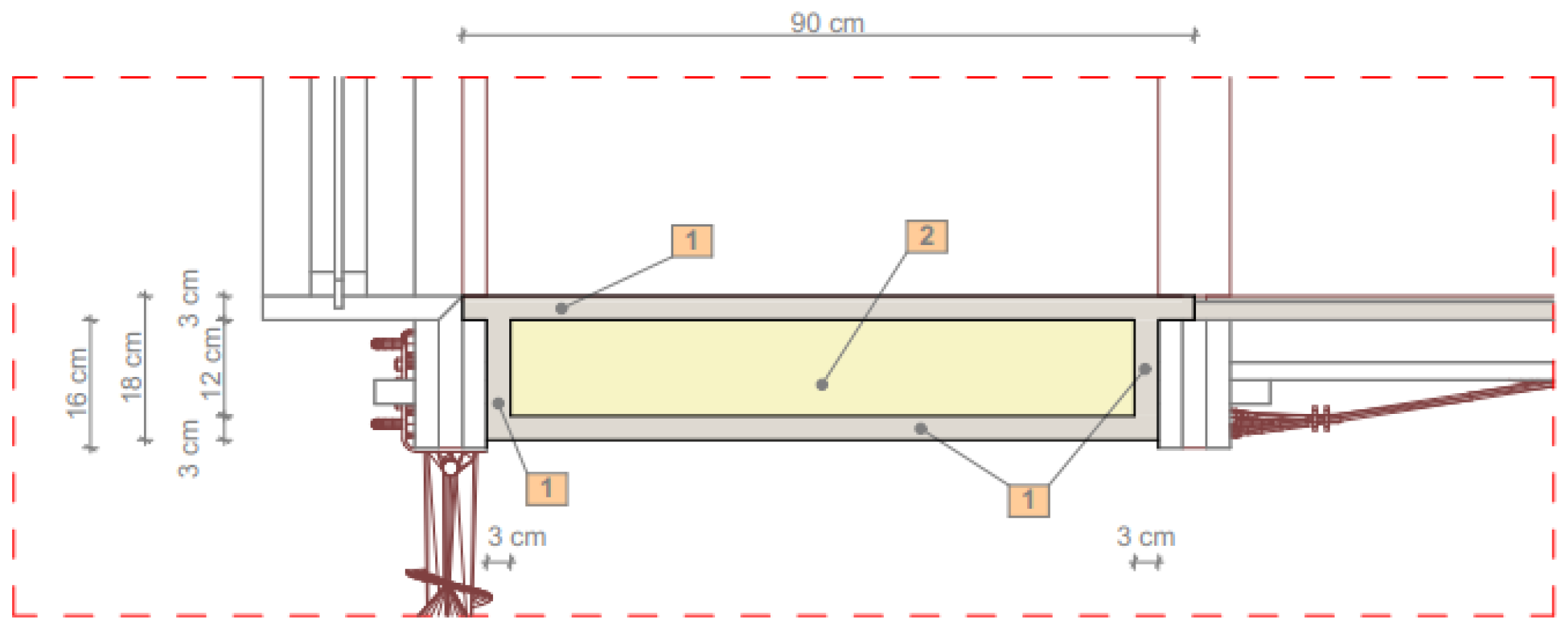

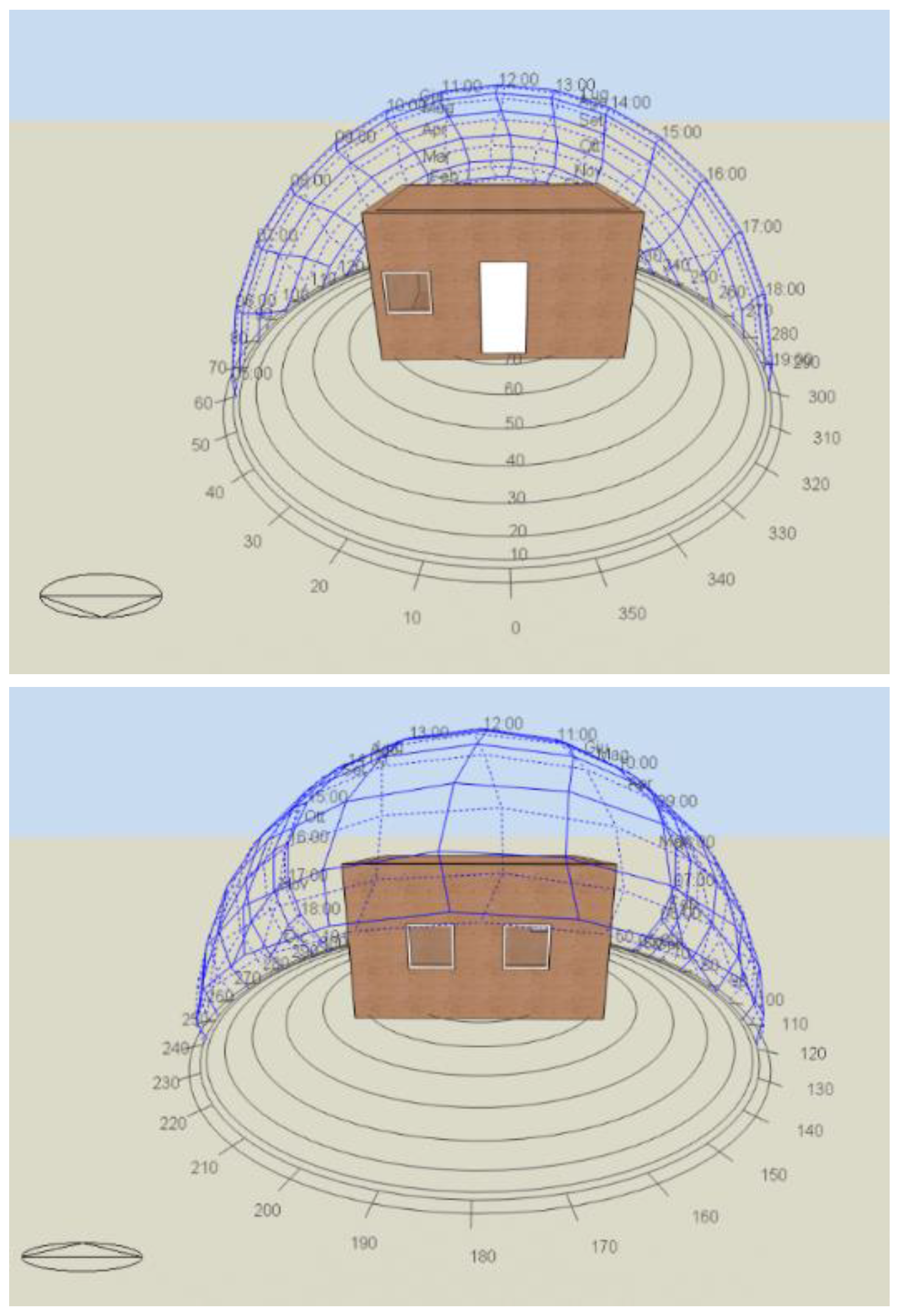
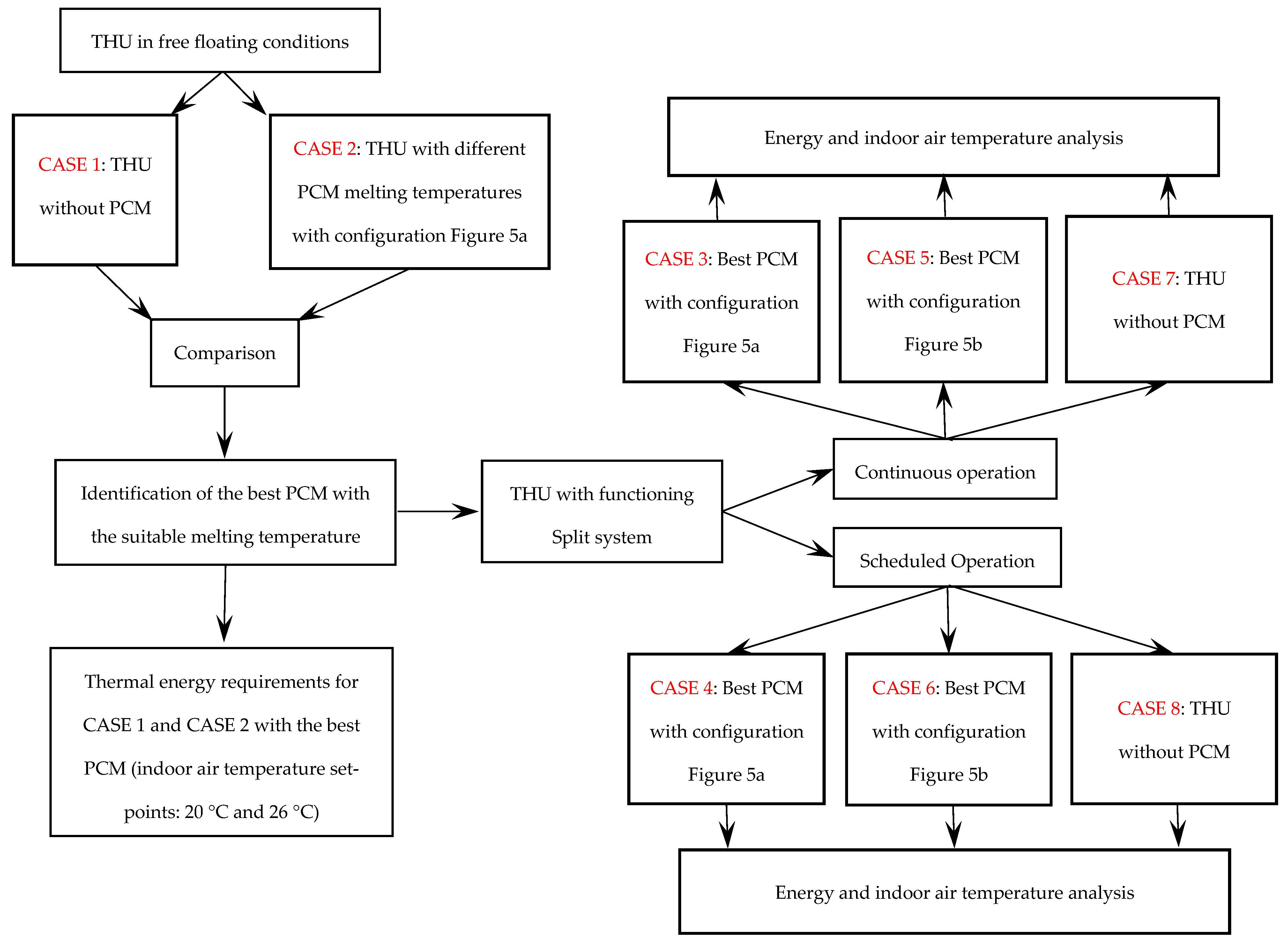


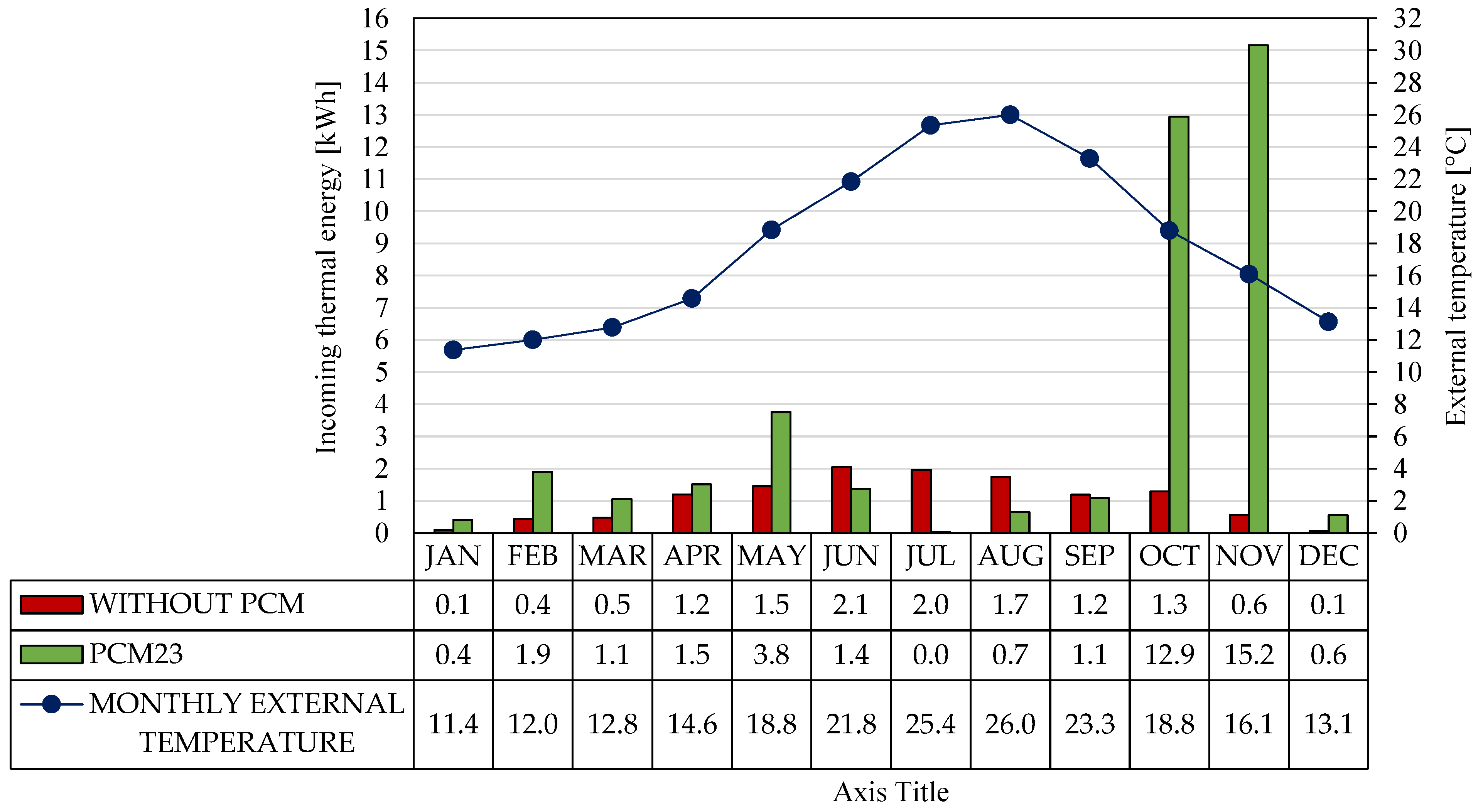
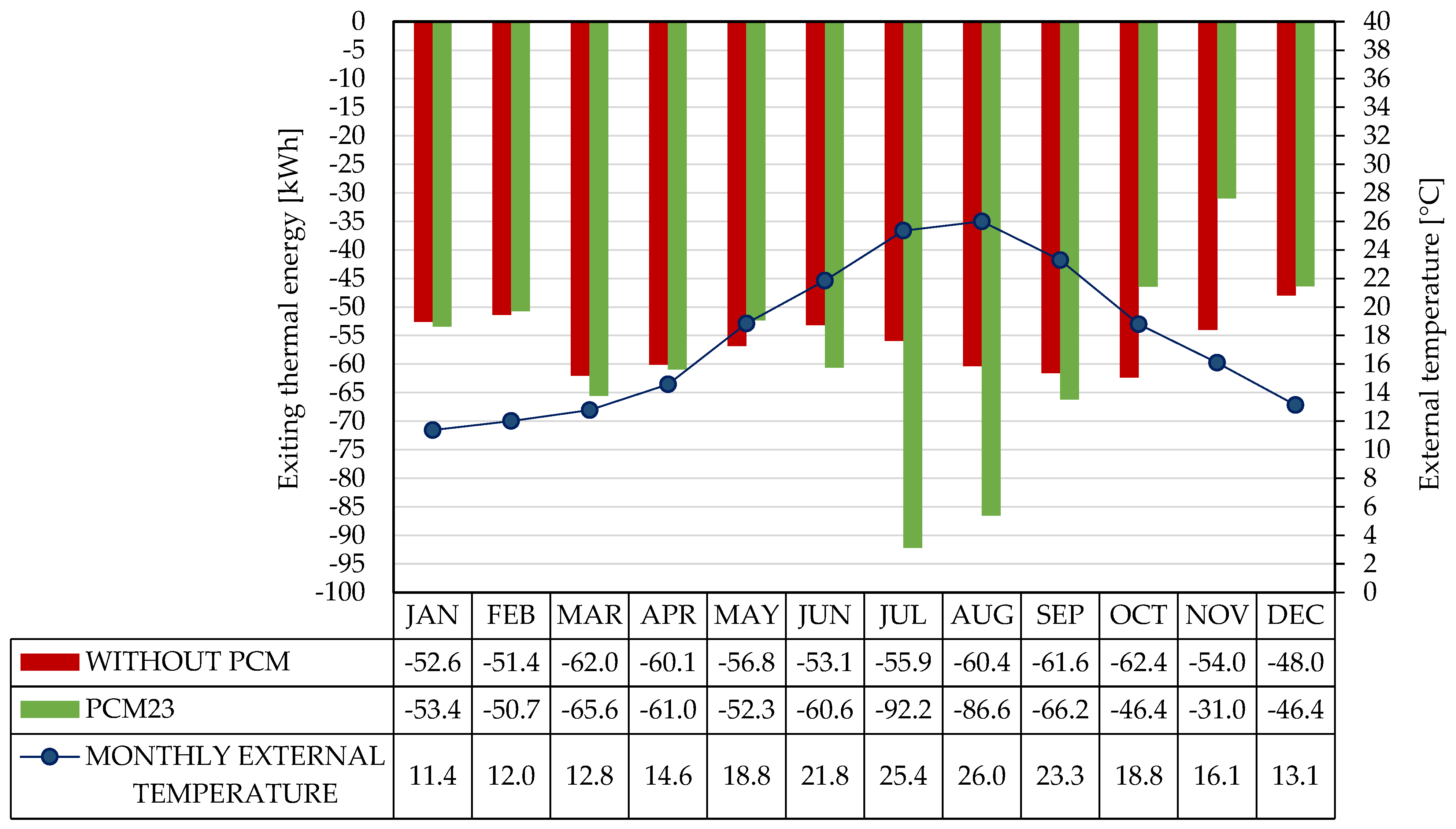


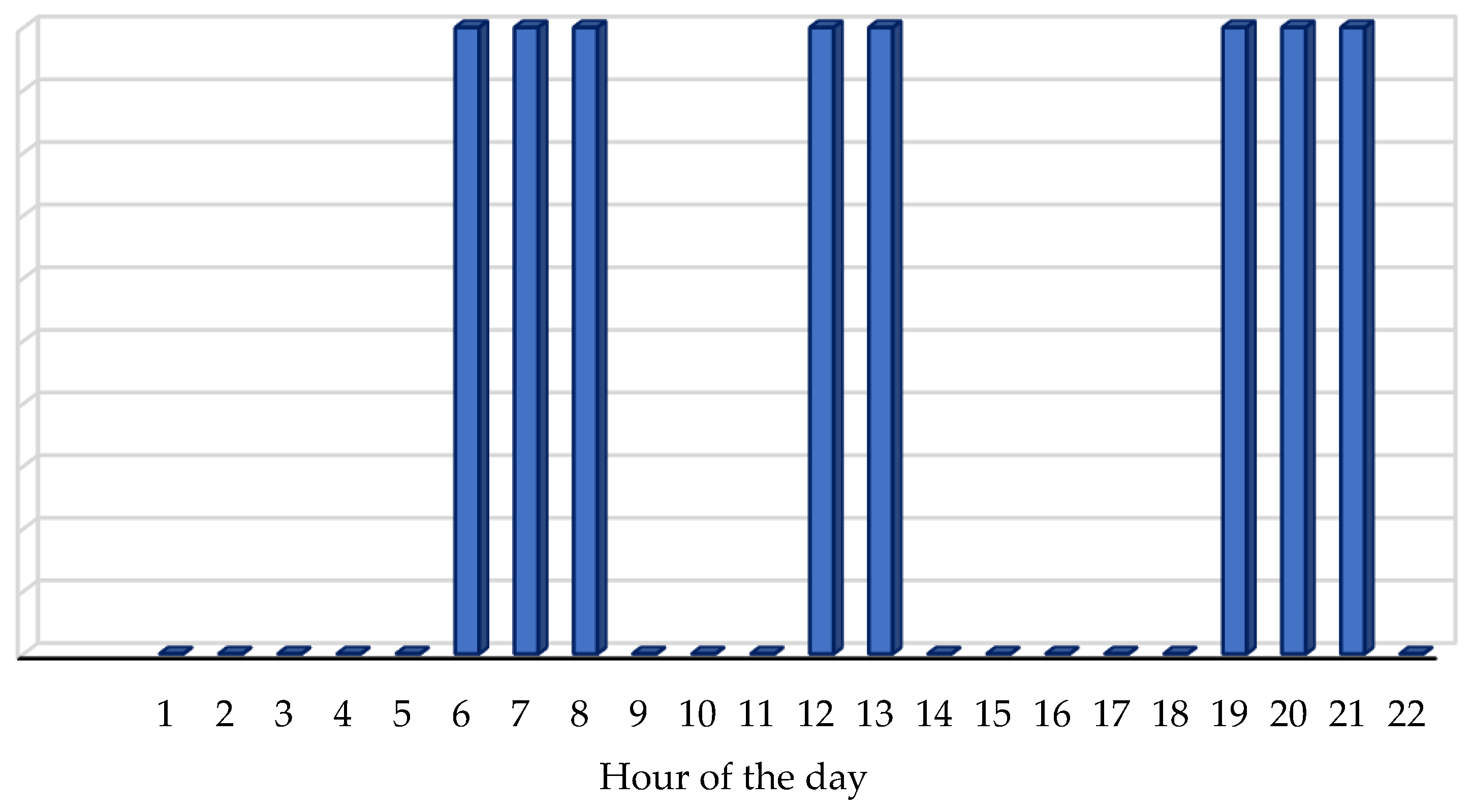
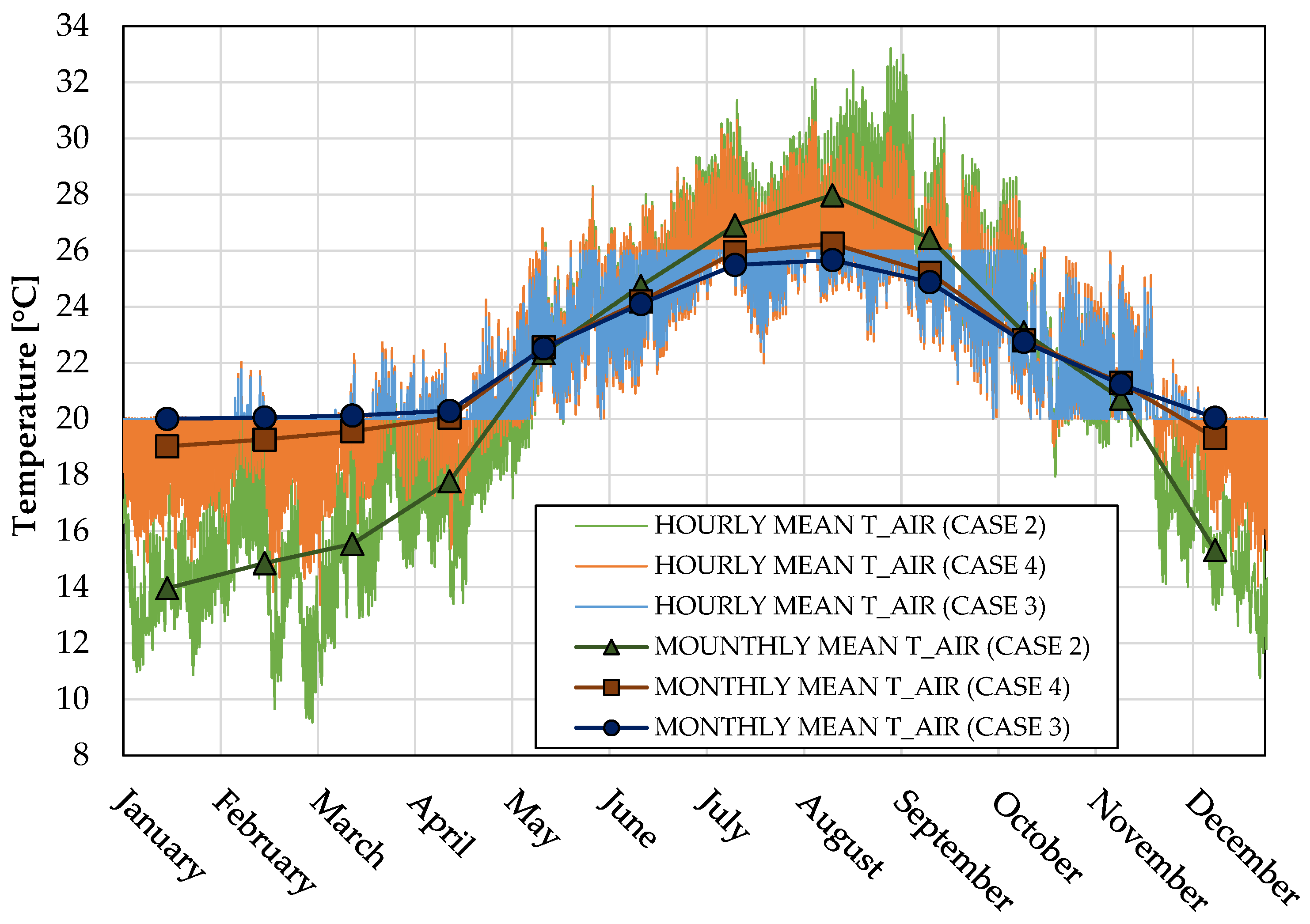

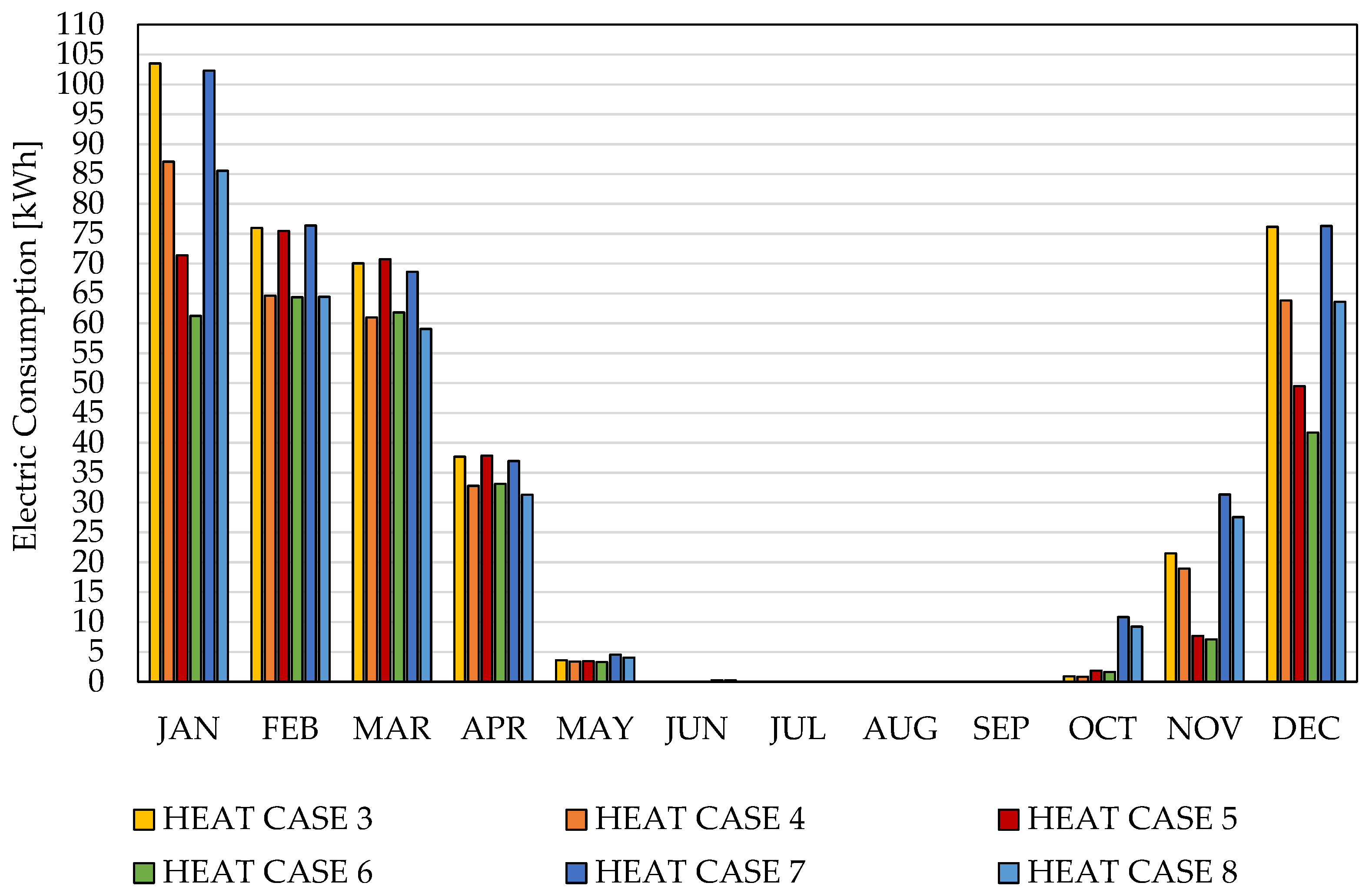
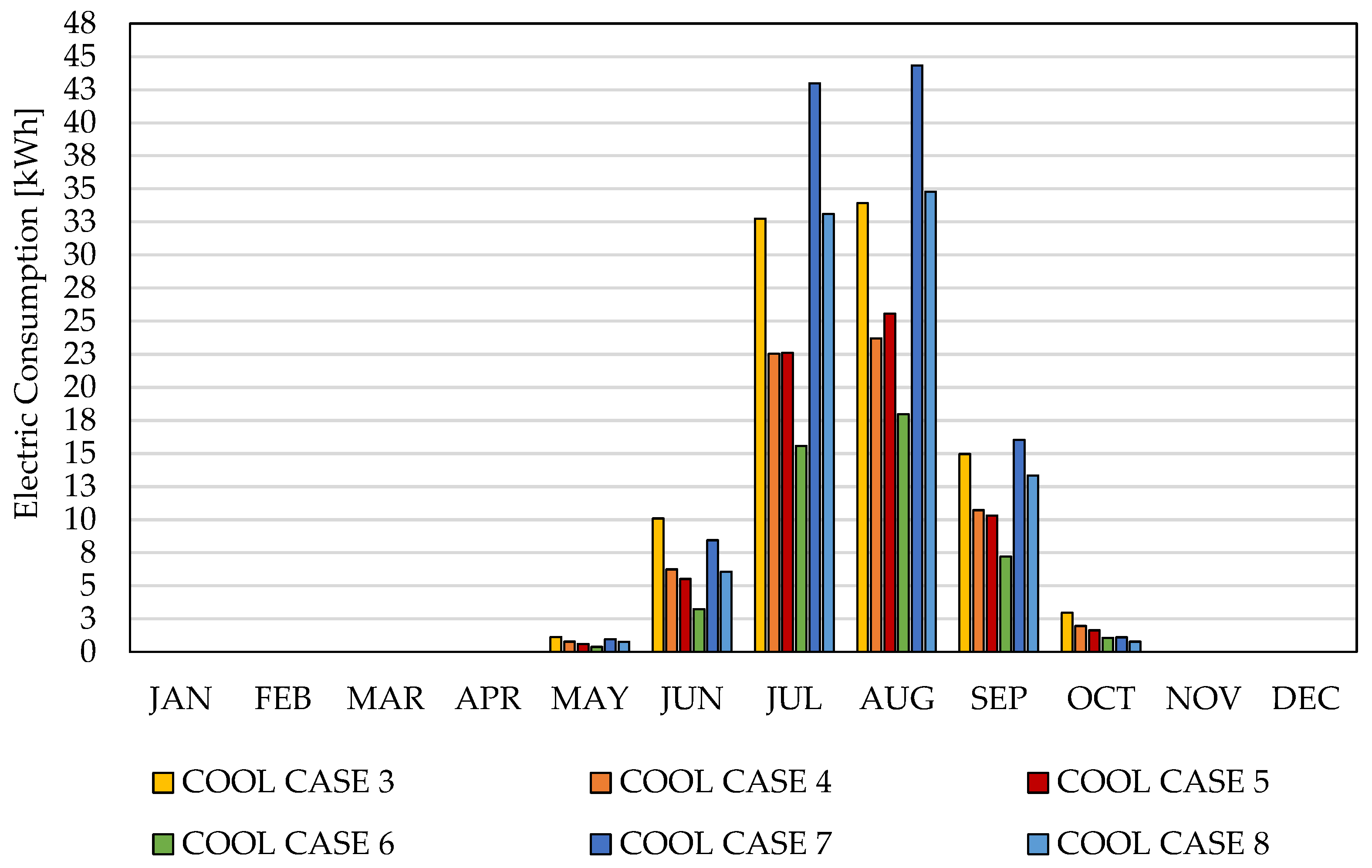
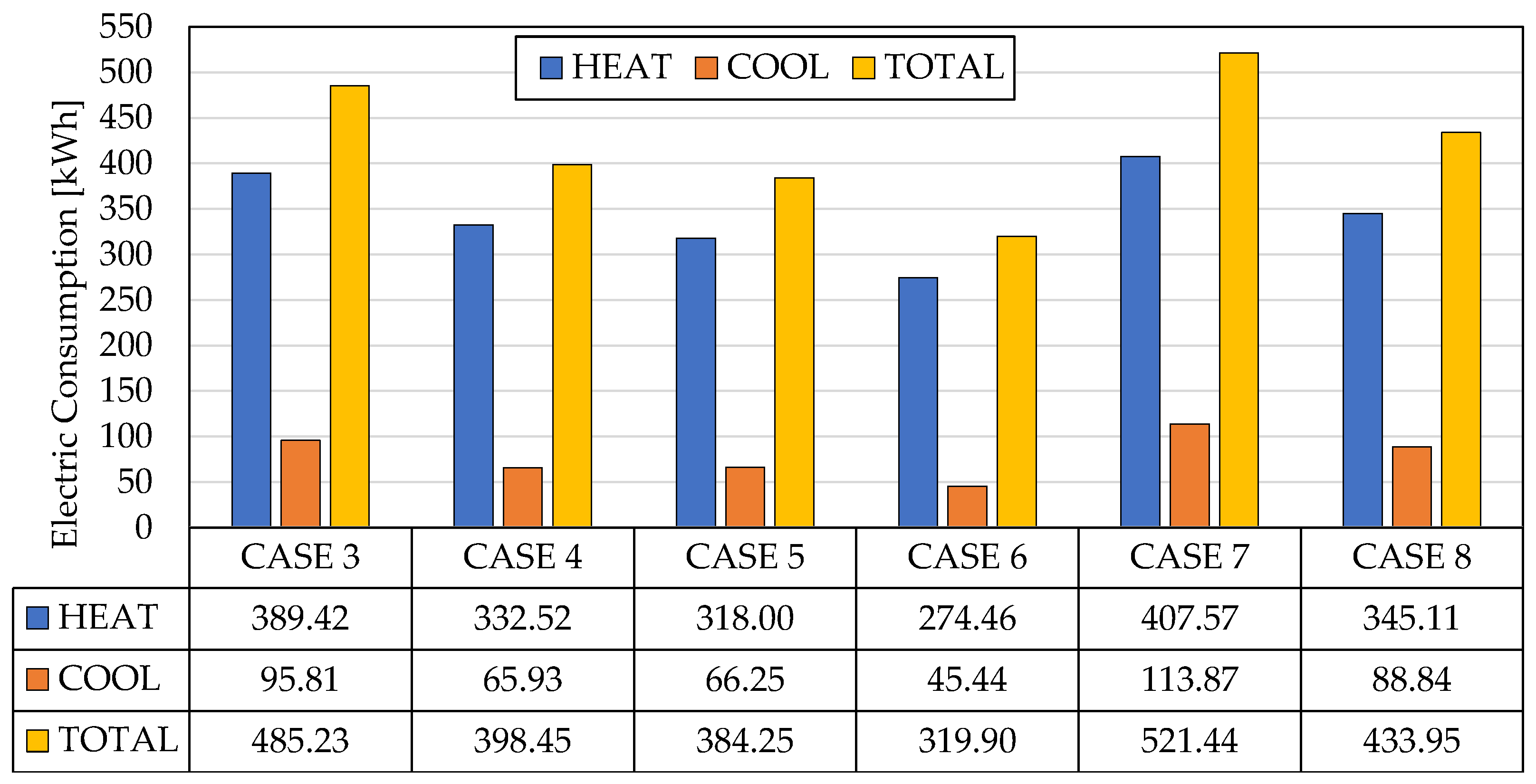
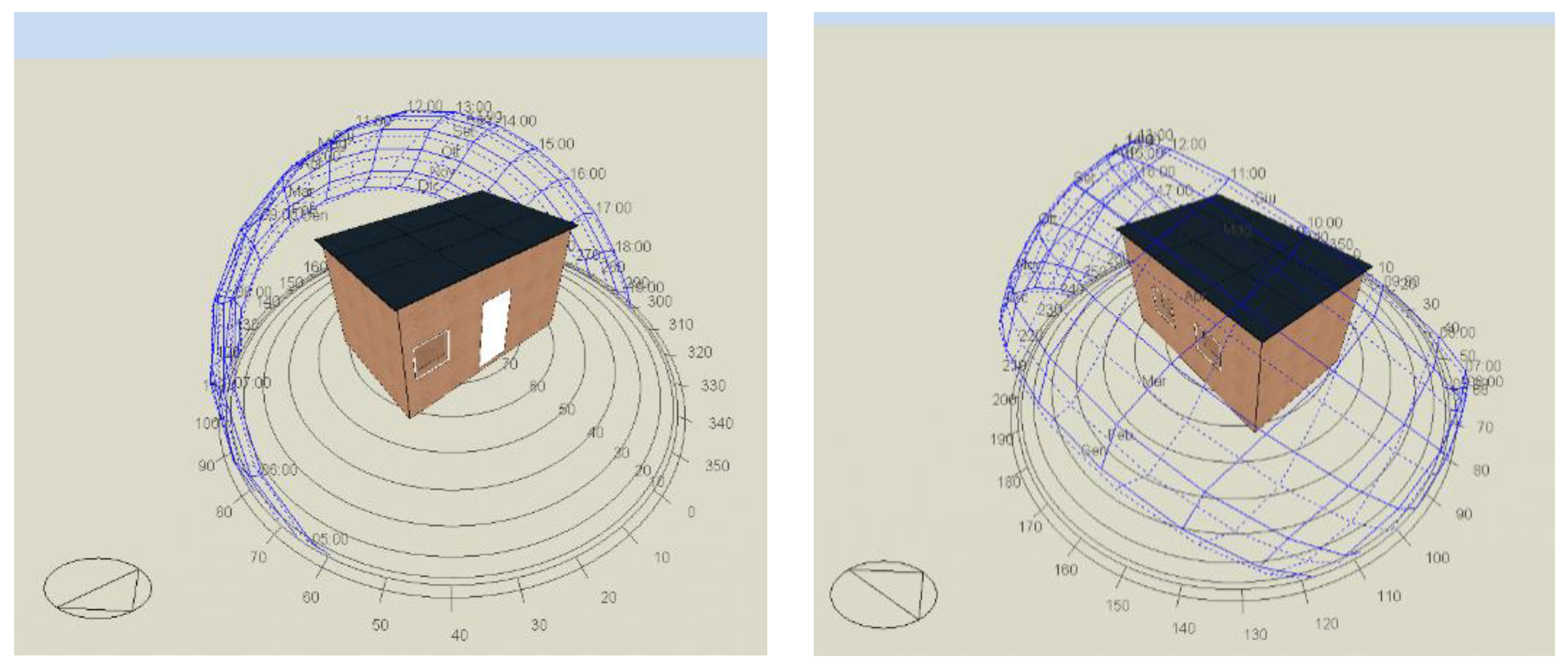





| Propriety | Value | Unity |
|---|---|---|
| Density | 100–220 | [kg/m3] |
| Thermal conductivity | 0.04 | [W/(m·K)] |
| Specific heat capacity | 1700–2100 | [J/(kg·K)] |
| Resistance to vapor diffusion | Classic cork 2–8 | [kg/m2sPa] |
| Cork panel 5–10 | ||
| Long-term use limits temperature | 110–120 | [°C] |
| Compressive strength | 100–200 | [kPa] |
| Flexural strength | 140–200 | [kPa] |
| Fire reaction | Material class—B2 |
| Material | Thermal Conductivity [W/(m·K)] | Heat Specific Capacity [J/(kg·K)] | Density [kg/m3] | Thermal Resistance [W/(m2·K)] | Emissivity | Solar Absorbance | Visible Absorbance |
|---|---|---|---|---|---|---|---|
| Cork (external) | 0.052 | 2491.9 | 145.85 | 1.154 | 0.94 | 0.3 | 0.3 |
| Air | / | 1004.5 | 1.225 | 0.180 | 0.9 | 0.7 | 0.7 |
| OSB | 0.15 | 2700 | 550 | 0.134 | 0.6 | 0.6 | 0.6 |
| Air | / | 1004.5 | 1.225 | 0.180 | 0.9 | 0.7 | 0.7 |
| Cork (internal) | 0.052 | 2491.9 | 145.85 | 1.154 | 0.94 | 0.3 | 0.3 |
| Material | Thermal Conductivity [W/(m·K)] | Heat Specific Capacity [J/(kg·K)] | Density [kg/m3] | Emissivity [-] | Solar Absorbance [-] | Visible Absorbance [-] |
|---|---|---|---|---|---|---|
| Flooring wood blocks | 0.14 | 1200 | 650 | 0.9 | 0.78 | 0.78 |
| Cork | 0.052 | 2491.9 | 145.85 | 0.94 | 0.3 | 0.3 |
| OSB | 0.15 | 2700 | 550 | 0.6 | 0.6 | 0.6 |
| Structure | U [W/(m2·K)] | SF |
|---|---|---|
| SuberWall for vertical walls | 0.336 (0.430) | - |
| SuberWall for ceiling | 0.336 (0.350) | |
| Floor module | 0.341 (0.440) | - |
| Window module | 1.966 (3.000) | 0.687 (0.350) |
| Door | 2.084 (3.000) | - |
| Thermal Conductivity [W/(m·K)] | ||||||
|---|---|---|---|---|---|---|
| Melting Point [°C] | Specific Heat [kJ/(kg·K)] | Latent Heat [J/g] | Solid | Liquid | Weight [kg/m2] | |
| PCM18 | 18 | 3.14 | 200 | 0.54 | 1.09 | 5.38 |
| PCM21 | 21 | 3.14 | 200 | 0.54 | 1.09 | 5.38 |
| PCM23 | 23 | 3.14 | 200 | 0.54 | 1.09 | 5.38 |
| PCM25 | 25 | 3.14 | 200 | 0.54 | 1.09 | 5.38 |
| PCM29 | 29 | 3.14 | 200 | 0.54 | 1.09 | 5.38 |
| PCM18 | PCM21 | PCM23 | PCM25 | PCM29 | CASE 1 | |
|---|---|---|---|---|---|---|
| Annual Hours | 2357 | 2953 | 3171 | 2453 | 1867 | 2290 |
| Annual Percentage | 27% | 34% | 36% | 28% | 21% | 26% |
| PCM18 | PCM21 | PCM23 | PCM25 | PCM29 | CASE 1 | Max | Min | |
|---|---|---|---|---|---|---|---|---|
| January | 0.0% | 0.0% | 0.0% | 0.0% | 0.0% | 0.0% | / | / |
| February | 3.0% | 1.5% | 2.8% | 2.8% | 1.5% | 1.2% | PCM18 | CASE 1 |
| March | 8.6% | 7.3% | 10.1% | 10.1% | 6.9% | 7.8% | PCM23 | PCM29 |
| April | 23.9% | 17.5% | 23.8% | 23.6% | 15.1% | 16.4% | PCM18 | PCM29 |
| May | 62.5% | 84.0% | 81.3% | 79.7% | 72.3% | 71.2% | PCM21 | CASE 1 |
| June | 79.0% | 88.2% | 66.5% | 48.3% | 68.1% | 67.2% | PCM21 | PCM23 |
| July | 10.1% | 23.1% | 25.5% | 10.3% | 0.4% | 10.3% | PCM23 | PCM29 |
| August | 2.0% | 2.0% | 4.3% | 3.1% | 0.0% | 3.0% | PCM23 | PCM29 |
| September | 40.4% | 43.9% | 40.1% | 33.5% | 10.3% | 41.3% | PCM21 | PCM25 |
| October | 62.6% | 75.5% | 81.0% | 71.5% | 50.9% | 62.4% | PCM23 | PCM29 |
| November | 27.9% | 54.4% | 90.6% | 51.8% | 29.6% | 31.9% | PCM23 | PCM29 |
| December | 2.6% | 6.2% | 7.5% | 0.3% | 0.0% | 0.3% | PCM23 | PCM29 |
| HEAT | COOL | Total | |
|---|---|---|---|
| CASE 3–CASE 7 | −4.5% | −15.9% | −6.9% |
| CASE 5–CASE 7 | −22.0% | −41.8% | −26.3% |
| CASE 4–CASE 8 | −3.6% | −25.8% | −8.2% |
| CASE 6–CASE 8 | −20.5% | −48.9% | −26.3% |
| PV Module | Storage | ||
|---|---|---|---|
| Module type | Monocrystalline | Effective energy [kWh] | 13.5 |
| Number of cells | 120 | Effective max power [kW] | 7 |
| Cell type | Heterojunction (HJT) | Inlet/outlet efficiency [%] | 90 |
| Module dimensions [cm] | 1.767 × 0.7041 × 0.035 | Dimensions | 1.15 × 0.755 × 0.155 |
| Weight [kg] | 19.7 kg | Weight | 125 |
| Rated power [Wp] | 380 | ||
| Reference efficiency [%] | 20.7 | ||
| Mean Charge | |
|---|---|
| Gen | 92.9% |
| Feb | 94.9% |
| Mar | 95.6% |
| Apr | 98.4% |
| May | 99.9% |
| Jun | 100.0% |
| Jul | 99.9% |
| Aug | 99.8% |
| Sep | 100.0% |
| Oct | 99.9% |
| Nov | 99.5% |
| Dec | 94.8% |
Publisher’s Note: MDPI stays neutral with regard to jurisdictional claims in published maps and institutional affiliations. |
© 2022 by the authors. Licensee MDPI, Basel, Switzerland. This article is an open access article distributed under the terms and conditions of the Creative Commons Attribution (CC BY) license (https://creativecommons.org/licenses/by/4.0/).
Share and Cite
Bruno, R.; Bevilacqua, P.; Rollo, A.; Barreca, F.; Arcuri, N. A Novel Bio-Architectural Temporary Housing Designed for the Mediterranean Area: Theoretical and Experimental Analysis. Energies 2022, 15, 3243. https://doi.org/10.3390/en15093243
Bruno R, Bevilacqua P, Rollo A, Barreca F, Arcuri N. A Novel Bio-Architectural Temporary Housing Designed for the Mediterranean Area: Theoretical and Experimental Analysis. Energies. 2022; 15(9):3243. https://doi.org/10.3390/en15093243
Chicago/Turabian StyleBruno, Roberto, Piero Bevilacqua, Antonino Rollo, Francesco Barreca, and Natale Arcuri. 2022. "A Novel Bio-Architectural Temporary Housing Designed for the Mediterranean Area: Theoretical and Experimental Analysis" Energies 15, no. 9: 3243. https://doi.org/10.3390/en15093243
APA StyleBruno, R., Bevilacqua, P., Rollo, A., Barreca, F., & Arcuri, N. (2022). A Novel Bio-Architectural Temporary Housing Designed for the Mediterranean Area: Theoretical and Experimental Analysis. Energies, 15(9), 3243. https://doi.org/10.3390/en15093243










